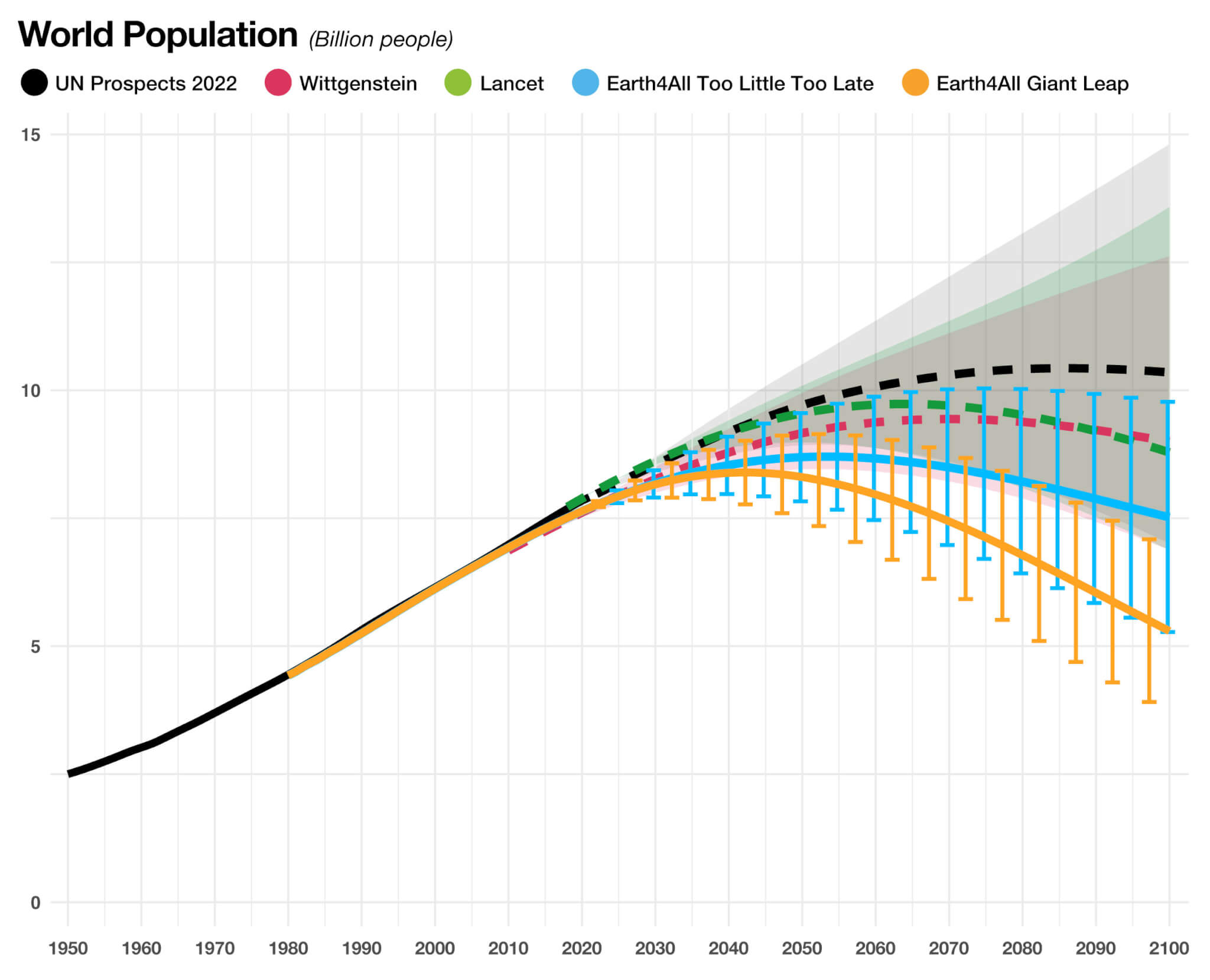ROME — The global population has steadily increased at a high rate for decades. For instance, in 2003 the population of the planet came in somewhere around 6.4 billion. Today, humanity has crossed the eight billion population mark. No shortage of studies and organizations attempt to predict what the future holds for humanity in terms of population statistics. Now, a new report states that if global society takes a “Giant Leap” in terms of investment in economic development, education, and health, the world population may peak at around 8.5 billion people by 2050.
This project was put together by scientists from the Earth4All initiative for the Global Challenges Foundation. Earth4All describes itself as an international initiative aimed at accelerating the systems-change urgently needed to promote an equitable future on a finite planet.
Study authors took advantage of a newly developed dynamics model, also referred to as Earth4All, to help them explore two distinct possible scenarios that could play out over the course of this century. The first scenario, called Too Little Too Late, entails the planet continuing to develop economically in the same way it has for the past 50 years. According to this version of events, many of the very poorest countries will actually break free from extreme poverty. Moreover, researchers estimate the global population may peak at around 8.6 billion in 2050 before declining to seven billion by the year 2100.
Meanwhile, the second potential scenario is called the Giant Leap. According to this possible sequence of events the world population will peak at roughly 8.5 billion people by the year 2040, before dropping off to around 6 billion by the end of the century. This future would only be made possible by an unprecedented investment in poverty alleviation. More specifically, big investments in education and health, along with extraordinary policy changes regarding food and energy security, inequality, and gender equity. This version of events would also lead to the end of extreme poverty in a generation (by 2060), along with a marked impact on global population trends.
Researchers also posit that additional prominent population projections often serve to undercut the vital importance of rapid economic development.

“We know rapid economic development in low-income countries has a huge impact on fertility rates. Fertility rates fall as girls get access to education and women are economically empowered and have access to better healthcare,” says Per Espen Stoknes, Earth4All project lead and director of the Centre for Sustainability at Norwegian Business School, in a statement.
“Few prominent models simulate population growth, economic development and their connections simultaneously,” comments Beniamino Callegari, an Associate Professor from Kristiania and member of the Earth4All modeling team.
World population will peak ‘sooner rather than later’ if economic development improves globally
The analysis performed for this project encompassed ten world regions including Sub-Saharan Africa, China, and the United States. Many countries and regions are currently experiencing very high population growth, including certain nations in Africa like Angola, Niger, the Democratic Republic of Congo and Nigeria, and Asia, for instance Afghanistan.
“If we assume these countries adopt successful policies for economic development then we can expect population to peak sooner rather than later,” Prof. Callegari continues.
The research team also analyzed any connections between population and exceeding planetary boundaries, which has been linked in the past to our planet’s “carrying capacity”. Meanwhile, in opposition in public popular myths, researchers add that population size is not the primary driver of exceeding planetary boundaries like climate change. Instead, it appears that the extremely high material footprint levels being produced by the world’s richest 10 percent is far more responsible for destabilizing our planet.
“Humanity’s main problem is luxury carbon and biosphere consumption, not population. The places where population is rising fastest have extremely small environmental footprints per person compared with the places that reached peak population many decades ago.” notes Jorgen Randers, one of leading modelers for Earth4All and co-author of The Limits to Growth.
Per the study’s demographic projections, it is possible for the entire global population to attain living conditions that exceed the United Nations minimum level without implementing major changes in reference to current developmental trends — provided there is an equal distribution of resources.
Moreover, study authors add that at the planet’s current population levels it is quite possible for everyone to avoid extreme poverty and enjoy a dignified life with access to food, shelter, energy and other resources. That being said, for this to happen it would require a much more equal distribution of global resources.
“A good life for all is only possible if the extreme resource use of the wealthy elite is reduced,” Randers concludes.

Nice job slipping socialism/communism at the end. The top 1% is over consuming, the top 10% are consuming a lot, but also generating all the technology and.progress on the planet. We need to reduce the population to the point that everyone has the material resources to live in the 80-99 percentile while not destroying the environment.
Reduce the population???? How about the fact that every single person could live in upper middle class luxury if the billionaires of this world would give only HALF of what they have. Don’t you see that money breeds greed? I’m not anti capitalist, just anti GREED. Also, the study finds that in 2050….HOLD IT! Nobody will be here in 2050, in fact nobody will be here on this earth the way it is going in 2030 except those fat cats who have built luxury facilities underground for the last 3 decades with the hard earned money of the taxpayers whom they are trying to destroy.
I absolutely agree the 1% is a huge cause of the problem. But cleaning them out will pay for 10 years of the JUST the US budget deficit. So saying everyone could live great off that money is not accurate.
You realize there are only 3,000 billionaires in the world. 600 in the United States. If you took everything from them and left them with nothing, it wouldnt change very much. Even if you were to put 100K in everyones bank account tomorrow it would be meaningless as everyone is the same. There would be little value because the cost associated would also increase due to rise in wealth. It would be the exact same situation except everybody is broke and poor. You then have a government class. And a society poor underneath. Look at every program thats tried a minimum standard income to lower class families. Its done nothing to change the situation at the expense of everyone else.
Get rid of Liberalism!
The people in poor countries are not overconsuming. The day they reach a first world standard of living, however, then they will be overconsuming. the people heralding the joys of an exponentially expanding human population are insane. repeatedly stating that overpopulation is a myth does not fix this problem. nor does supposing that science fiction level technology will be invented in time to fix it
That’s all nice, what you said, but it ignores the fact that people have been hearing this for 100 years and it hasn’t happened.
Sounds like the WEF funded this study, balderdash. Trying to predict all those variables is like trying to predict weather, good luck.
When the baby booms leave this world and the following generation, the population will drop below 2 billion people.
Global Waring is the symptom, World poulation is the problem. Peaking at 8.5M will solve neither.
The world will begin depopulating soon so all of you Malthusians can chill a bit. In 200 years the population will be about 1 billion souls. Think on that for a bit.
Huge hole in this piece by not covering the factors contributing to the decline in population following the peak. As for who is destroying the planet – we all are – and tossing out a single stat only invites scorn. Don’t Russia, Pakistan, India and China get an honorable mention? Think they’ll actually follow a climate accord? Its a global issue with a host of bad actors. Blamestorming is not constructive.
Study finds: most studies have an agenda with data skewed by it’s creator.
Earth can hold over 24 billion if we switch diets. Plant-based diets contain all nutrients, are healthy, cheaper, tasty, take less resource. Animal farming takes around 3x land and water. Rather than blaming elites, we should blame ourselves. Humans are not apex predators by nature but nurture. Human herbivore cultures prove this. To ensure freedom of choice and faith, charge people’s footprint, and markets will eventually solve things as consumers buy on price. Currently environmental destruction is subsidised. The problem is not overpopulation but excess resource use. The cost of bio-repair is 3,5 trillion, or 7% of incomes. See https://greenlivinguk.org/footprint-charges-for-a-sustainable-economy-a-new-social-contract/